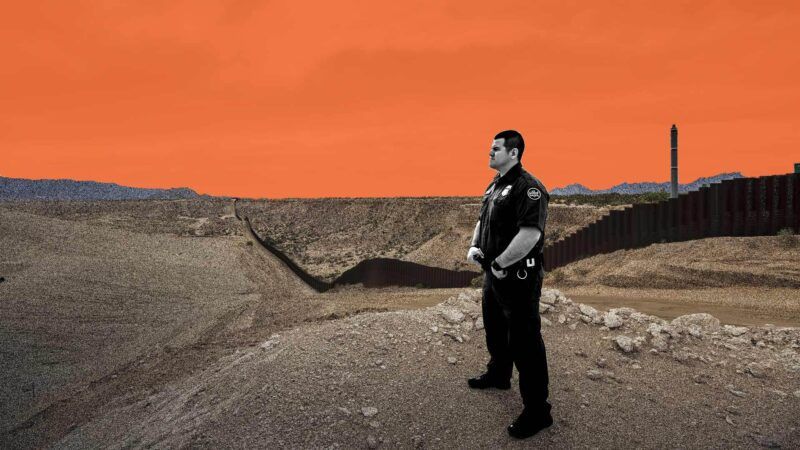The 'Big Beautiful Bill' Funds an Expensive Immigration Crackdown
Billions upon billions of dollars are allocated for border screening technology, immigration detention facilities, more ICE agents, and building a border wall.

President Donald Trump signed his One Big Beautiful Bill Act (OBBBA) into law on Friday. The sweeping legislation includes boosts to military funding, more taxpayer financing of state-sponsored events, and massive appropriations to the Department of Homeland Security (DHS).
Here are some of the bill's largest line items aimed at implementing Trump's immigration crackdown.
1. Over $6 Billion for Autonomous Screening Technology at the Border
The OBBBA will "combat the entry or exit of illicit narcotics at ports of entry" by procuring "new nonintrusive inspection equipment," including artificial intelligence (AI), air and marine operations, surveillance technologies, and biometric entry and exit systems to screen individuals. None of the funds may be used for the procurement or deployment of surveillance towers along the northern or southern borders, unless Customs and Border Patrol has tested and accepted that the towers deliver "autonomous capabilities," or "a system designed to apply artificial intelligence…to accurately detect, identify, classify, and track items of interest in real time…without the active engagement of personnel or continuous human command or control."
The implementation of this technology should be met with scrutiny. Few guidelines exist on the federal government's use of AI, which invites risks to due process and civil liberties for both migrants and American citizens. While "border security" sounds like an appealing use case to some, without transparency and limitations on how and when the technology can be used, the tools could be adapted to meet other ends. In fact, it has already happened—Immigration and Customs Enforcement (ICE) agents are currently using facial recognition technology that was designed to track border crossings in the field to aid in Trump's immigration crackdown.
2. $56.5 Billion To Build a Border Wall
The "big beautiful bill" will increase physical barriers to immigration by allocating a little over $46.5 billion to the DHS for "border infrastructure and [a] wall system." This funding will be used to construct or improve "primary, waterborne, and secondary barriers," install cameras and other detection technology along the border, and construct and maintain "the barrier system." The OBBBA also creates a $10 billion State Border Security Reinforcement Fund at the DHS that will reimburse states for building a wall along the southern border or capturing and relocating undocumented immigrants.
The estimated costs to build a wall along the U.S.-Mexico border range from a conservative $12 billion to more than $70 billion, which doesn't include land acquisition costs. Despite campaign promises to build the wall in 2016, Trump completed only 452 miles during his first term—only 80 miles of which were new barriers, with the remaining 372 miles replacing existing structures built by previous administrations. Trump's first-term border wall construction cost taxpayers $15 billion, or about $33 million per mile of border wall.
3. Nearly $75 billion for ICE's Mass Arrest and Detention Campaign
The OBBBA supersizes ICE's detention budget by providing the agency with $45 billion for "single adult alien detention capacity and family residential center capacity." This "represents a 265 percent annual budget increase to ICE's current detention budget," according to the American Immigration Council, and is "a 62 percent larger budget than the entire federal prison system [that] could result in the daily detention of at least 116,000 non-citizens." This comes alongside nearly $29.9 billion in additional funding for new ICE personnel, transportation costs, and facility maintenance—a more than threefold increase from ICE's $9.5 billion budget in FY 2024. Such a dramatic budget increase could substantially expand the agency's ability to make arrests.
ICE's limited detention capacity—officially set at 47,600 beds, though it was holding 56,397 earlier this year—has become a roadblock to Trump's mass deportation goals. The bottleneck has pushed the administration to experiment with new and controversial ways of detaining migrants, such as sending detainees to El Salvador and the opening a new state-run immigration detention center known as "Alligator Alcatraz." But spending billions of dollars to increase space will do little to address the systemic failures of the U.S. immigration system. "Throwing billions at detention centers and enforcement agents is short-sighted," said Adriel Orozco, senior policy counsel at the American Immigration Council. "Instead, we should be investing in a system aimed at welcoming immigrants that contribute billions to our economy."


Show Comments (83)